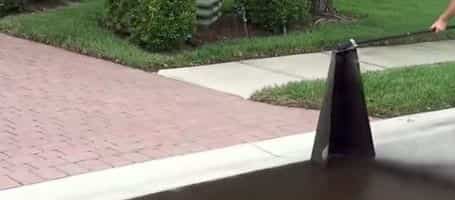One of the age-old debates in the world of asphalt maintenance has got to be surrounding methods of sealcoat edging. But which truly is better – edging a sealcoat by hand or using a specialist piece of equipment?
The truth is, there really is no right answer, but each method does have its own unique benefits. The correct choice may totally depend on the nature of the job at hand.
Let’s take a look through the pros and cons of each sealcoat edging technique, so you can decide which is the best way to go for you and your company.
Edging by Hand
Pros:
- Greater control. There’s no denying that simple tools like brushes offer better control than spraying equipment, and the type of brush fibre can easily be adjusted depending on the desired finish. For example, stiff brushes are a great option for enhanced control in tricky areas, but softer bristles leave fewer brush marks for a cleaner finish.
- Relatively unaffected by wind. When using a sprayer, it may be necessary to have a backer board to control overspray and minimize the effects of wind. When using a brush or squeegee, however, wind does not pose any great threat to the final result.
Con:
- Difficult to use precisely the correct amount of sealer. When carrying out edging by hand it’s very easy to use either too much or too little product. Both of these issues may lead to more product being used than necessary, or a more time-consuming process – both of which could be bad news for profits.
Edging using Specialist Equipment
Pros:
- Time saving. Investing in a high-quality, specialist piece of equipment to help you with edging is certainly a wise investment. For example, this sealcoat edger attaches to a spray system and can make the process much more efficient, and greater efficiency = greater profit!
- Can make it a one-person job. Granted, some sprayers may require an extra pair of hands to hold a backer board and prevent overspray, but the best sealcoat edgers will take care of this for you. This reduced need for manpower allows your colleagues to work on another job and gather profits from elsewhere in the meantime!
Con:
- Be mindful of overspray. As we briefly mentioned, there are some pieces of equipment (particularly sprayers) that do not feature in-built wind protection. Although sprayers have an array of benefits, the potential effect of strong gusts on their performance is worth considering. Be sure to keep a spray bottle of sealer remover nearby at all times to clean up any overspray promptly.
To conclude, each method of sealcoat edging has its own benefits and potential problems. Which is best for you is simply down to the type of job you’re completing, as well as personal preference.
Using a sealcoat brush to cut in, followed by a spray and backer board is often favored for residential jobs. Conversely, sealcoat edgers are particularly useful for commercial projects where there is lots of area to cover, for increased efficiency.
We hope we have helped you weigh up the pros and cons of each of these great methods, and we’d love to hear what your personal preferences are when it comes to sealcoat edging. Learn more about asphalt sealcoating and How to Sealcoat Edges.




